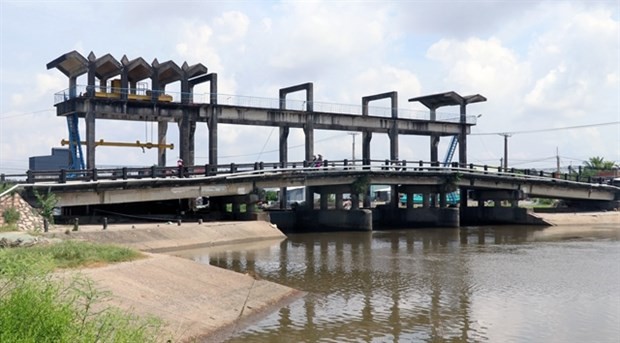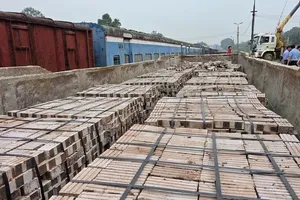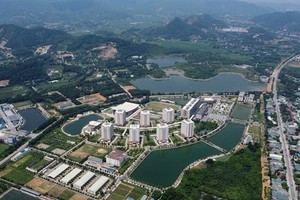
Saltwater intrusion is expected to be more severe this year because of low flooding levels and lower than usual rainfall during the rainy season, according to local authorities.
During the dry season, saline intrusion will occur earlier than usual, causing a shortage of fresh water for agricultural production, according to the Southern Institute of Water Resources Research.
Kien Giang province's People’s Committee has told agencies to dredge irrigation canals to improve water storage and to build temporary dams to prevent saline intrusion.
The province plans to complete construction of 173 temporary dams by mid-month. The affected coastal areas are located from Rach Gia city to Ha Tien city, along the Cai Lon - Cai Be rivers, and in the U Minh Thuong area.
Water with a salinity of 0.4 percent is expected to enter 40km deep into the Cai Lon River in January, according to the Kien Giang Centre for Hydro-Meteorology Forecasting.
The highest salinity rate is expected by the end of April and early May.
In Tra Vinh province, sluice gates are being closed when the salinity reaches more than 0.1 percent.
The province's Department of Agriculture and Rural Development is continuing to repair sluice gates, dredge irrigation works, and clear water hyacinth and other obstacles on irrigation canals to facilitate the flow of water to fields.
In August, Ben Tre province upgraded irrigation works and instructed local residents to store fresh water.
Nguyen Quang Thuong, deputy head of Ben Tre’s Irrigation and Storm and Flood Prevention and Control Sub-department, said: “The rainy season is ending and saltwater has intruded into the province’s main rivers.”
Can Tho city is located 65km from the sea and is normally not affected by saltwater intrusion, but authorities are taking similar measures because of the impact of climate change.
Nguyen Chi Kien, deputy director of the Can Tho Department of Agriculture and Rural Development, said that rising sea levels had caused saltwater to enter more deeply into rivers and canals in the city.
The salinity of the Hau River, a tributary of the Mekong, has reached 0.22 percent, exceeding the permitted level for household use and agricultural production, according to the Can Tho Centre for Environmental and Natural Resource Monitoring.
Authorities in the delta’s coastal provinces have told farmers to plant the 2019-20 winter-spring rice early to avoid saline intrusion at the end of the crop.
Soc Trang province, for example, has urged farmers to sow the winter-spring rice crop 15 to 30 days earlier than they normally do.
Nguyen Thanh Phuoc, head of the Soc Trang Sub-department of Plant Cultivation and Protection, said that more than 23,000ha in the winter-spring rice would be sown earlier than usual.
In Tra Vinh province, at least 66,000ha of the winter-spring rice crop will be sown between November 20 and December 30, according to Pham Minh Truyen, director of the province’s Department of Agriculture and Rural Development.
For the winter-spring crop, the department has encouraged farmers to use certified seeds of rice varieties that are high quality, have short-term maturity, and are resistant to saltwater.
Farmers in Tra Cu and Cau Ngang districts have been urged to switch from rice to other crops during the winter-spring season.
The delta expects to sow more than 550,000ha of the 2019-20 winter-spring rice crop earlier than usual, an increase of 30 percent against the 2018-19 winter-spring crop, according to the Ministry of Agriculture and Rural Development.
Fresh water storage
Delta authorities are taking steps to help households have enough fresh water.
In Tra Vinh province, for example, more than 9,000 households face a water shortage in the dry season, according to the province’s Clean Water and Rural Environment Sanitation Centre.
The centre will ensure that households have enough water when saltwater intrusion occurs.
Bui Van Mung, director of the centre, said: “The centre has assigned staff at water supply stations to monitor high tides and pump fresh water for storage.”
The centre has also asked the province to allocate 18 billion VND (780,000 USD) to invest in water supply pipes and other facilities.
Water pipes will transport water from water supply stations to affected areas, and water reservoirs will store fresh water. Plastic water tanks will be given to 2,000 households who are located far from residential areas.
In Ca Mau province, as many as 13,500 households of 226,000 households in rural areas without access to tap water or groundwater are facing a severe fresh water shortage in the dry season.
Ca Mau is building water supply projects and providing water containers to poor households in areas that lack fresh water.
























